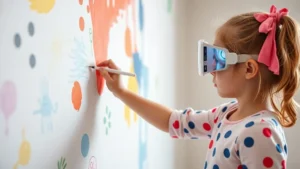 Picture a 6-year-old using augmented reality glasses to paint virtual murals (turned physical on “publish”) on their bedroom walls. That’ll be normal for Gen Beta. The boundary between “online” and “real-life” blurs until it’s almost nonexistent.
Picture a 6-year-old using augmented reality glasses to paint virtual murals (turned physical on “publish”) on their bedroom walls. That’ll be normal for Gen Beta. The boundary between “online” and “real-life” blurs until it’s almost nonexistent.
In my ‘Discover Your Future’ sessions, we create augmented experiences to show how immersive they can be. The key? Making sure digital tools enhance human connection rather than replace it.
By the way, my living room would never forgive me for the AR disasters I’d foist upon it!
Why It Matters:
- Pew Research state that 96% of Americans own a smartphone; for Gen Beta, extended reality technologies could well be as ubiquitous!
- Blending virtual and real environments will boost learning (e.g, VR field trips) but also intensify screen-time and ‘in-world’ concerns around addiction.
How do we preserve genuine face-to-face connections in a world where everything can be experienced virtually?
